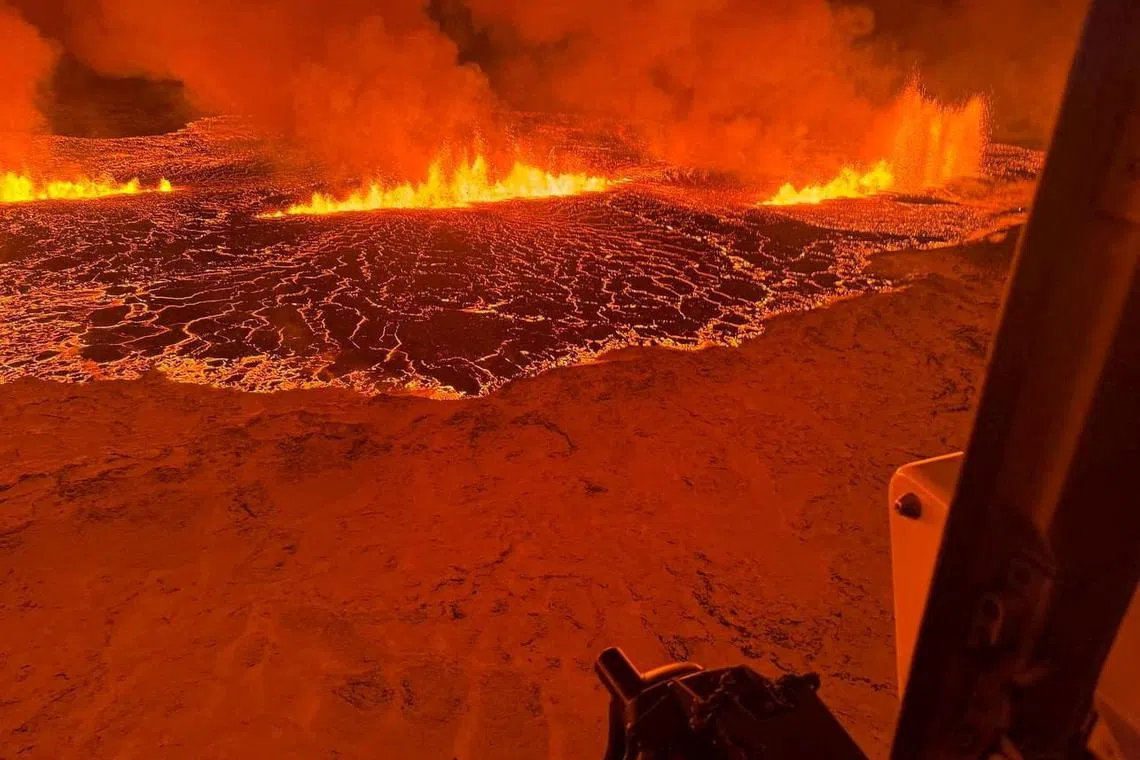Iceland’s volcanic eruption is dramatic, but it won’t cool the planet
Sign up now: Get ST's newsletters delivered to your inbox

Eruptions typically have a cooling effect when they eject ash and other compounds into the atmosphere.
PHOTO: REUTERS
Follow topic:
REYKJAVIK – A volcanic eruption on Iceland’s Reykjanes Peninsula sent lava flowing through a 4km crack in the Earth’s crust on Dec 18.
The eruption began in earnest and occurred near the evacuated fishing town of Grindavík
While volcanic eruptions can help temporarily cool the planet, this one is not likely to provide any type of significant climate impact, despite the dramatic videos and images.
Eruptions typically have a cooling effect when they eject ash and other compounds, including sulphur dioxide, into the atmosphere.
Once aloft, sulphur dioxide interacts with water to form what are known as aerosols, which are tiny particles that act like a mirror, reflecting incoming solar radiation back into space.
This means that less heat reaches the earth.
Adding extra sulphur dioxide to the atmosphere can also enhance cloud formation in certain cases, which further reflects solar radiation away from the planet.
When volcanoes put enough aerosols in the atmosphere, the cooling effect can last several years and span an entire hemisphere.
An example of this phenomenon was on display in 1991 when Mount Pinatubo erupted in the Philippines.
The volcano sent about 15 million tonnes of sulphur dioxide into the atmosphere. In response, the global average temperature dropped 0.6 deg C.
In the case of the Icelandic eruption, however, a large ash cloud is unlikely.
This is in part because the magma burbled out of the earth on land, which can generate less explosive ash plumes than when lava interacts with water.
In 2010, lava from Volcano Eyjafjallajokull in the south of Iceland made contact with ice on the mountain’s flanks, creating a massive cloud of ash that grounded European air travel for weeks.
The chemical composition of the magma coming up from the earth also makes it unlikely to result in major ash clouds, according to Portland State University professor of geology Jonathan Fink.
“It’s a particular kind of magma – basalt,” he said. “Those eruptions don’t tend to eject as much material high up where they can reflect sunlight.”
Volcanic eruptions can sometimes also have a warming effect on the planet by releasing greenhouse gases into the atmosphere.
But that is generally far outweighed by the amount humans emit, according to earth sciences professor Drew Shindell from Duke University’s Nicholas School of the Environment.
The relatively small size of the eruption, and thus low emissions of greenhouse gases, means that there is likely to be no warming, Prof Fink said.
And with the Icelandic eruption unlikely to produce enough aerosols to have a meaningful impact on the earth’s temperature either, the world would not get a reprieve from global warming.
In addition to climate change fuelled by greenhouse gases, El Nino – another natural phenomenon – is much more likely to increase temperatures in the coming year. BLOOMBERG

